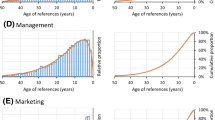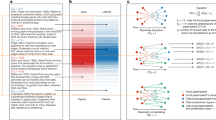Abstract
The paper discusses the application of three well known diffusion models and their modified versions to the growth of publication data in four selected fields of S&T. It is observed that all the three models in their modified versions generally improve their performance in terms of parameter values, fit statistics, and graphical fit to the data. The most appropriate model is generally seen to be the modified exponential-logistic model.
Similar content being viewed by others
References
Gilbert, G. N. (1978), Measuring the growth of science: A review of indices,Scientometrics, 1(1):9–34.
Solla Price, D. J. de. (1961),Science Since Babylon, New Haven, Connecticut; Yale University Press.
Solla Price, D. J. de (1963),Little Science, Big Science, New York; Columbia University Press.
Rogers, E. M. (1962),Diffusion of Innovations, New York; Free Press of Glencoe.
Valente, T. W. (1995),Network Models of the Diffusion of Innovations. NJ; Hampton Press, Inc.
Rogers, e. M.,Shoemaker, F. F. (1971),Communication of Innovations: A Cross Cultural Approach, New York; The Free Press.
Alber, R., Adams, J. S., Gould, P. (1971),Spatial Organisation, Englewood Cliffs, N J: Prentice Hall.
Kumar, V., Kumar, U. (1992), Innovation diffusion: some new technology substitution models,Journal of Mathematical Sociology, 17(2–3): 175–194.
Mansfield, E. (1961), Teehnical change and the rate of immitation,Econometrica, 29:741–766.
Griliches, Z. (1957), Hyorid corn: An exploration in the economics of technological change,Econometrica, 25: 501–522.
Robinson, B., Lakhani, C. (1975), Dynamic Price models for new product planning,Management Science, 21:1113–1122.
Brown, L. A. (1981),Innovation Diffusion: A New Perspective, New York; Methuen.
Casetti, E., Sample, R. K. (1969), Concerning and testing of spatial diffusion hypothesis,Geographical Analysis, 1:254–259.
Sahal, D. (1981),Patterns of Technological Innovations, Rading, MA; Addison-Wesley.
Sahal, D. (1983), Invontion, innovation and economic evaluation,Technological Forecasting and Social Change, 23:213–235.
Karmeshu;Bhargava, S. C., Jain, V. P. (1985),Urban Economics, 15:137–141.
Blackman, A. W. Jr. (1971), The rate of innovation in the commercial aircraft jet engine market,Technological Forecasting and Social Change, 2:3–4.
Blackman, A. W. Jr. (1972), A mathematical model for trend forecast,Technological Forecasting and Social Change, 3: 441–452.
Nevers, J. V. (1972), Extensions of a new product growth model,Sloan Management Review, 13: 78–79.
Easingwood, C. J., Mahajan, V., Muller, E. A. (1981), Non-symmetric responding logistic model for technological substitution,Technological Forecasting and Social Change, 20:199–213.
Teotia, A. P. S., Raju, P. S. (1986), Forecasting the market penetration of new technologies using a combination of economic cost and diffusion models,Journal of Product Innovation Management, 3: 225–237.
Bewley, R., Fiebig, D. G. (1986), A flexible logistic growth model with applications in telecommunications,International Journal of Forecasting, 3: 225–237.
McGowan, I. (1986), The use of growth curves in forecasting market developments,Journal of Forecasting, 5(1): 69–71.
Hamblin, R. L;Jacobsin, R. B., Miller, J. L. L. (1973),A Mathematical Theory of Social Change, New York; John Wiley.
Mahajan, V., Peterson, R. A. (1985),Models for Innovation Diffusion, Beverly Hill; Sage Publications, p. 10.
Mahajan, V., Scholeman, M. E. F. (1977), Generalized model for the time pattern of the diffusion process,IEEE Transactions on Engineering Management, EM 24(1):12–18.
Bass, F. M. (1969), A new product growth model for consumer durables,Management Science, 15: 215–227.
Sharma, L., Basu, A., Bhargava, S. C. (1993), A new model of innovation diffusion,Journal of Scientific and Industrial Research, 52 (3): 151–158.
Sharma, P., Bhargava, S. C. (1994), A non-homogenous non-uniform influence model of innovation diffusion,Technological Forecasting and Social Change, 46:279–288.
Sharma, P., Bhargava, S. C. (1996), Study on diffusion pattern and forecast of Indian electronic consumer durables,Journal of Scientific and Industrial Research, 55(7):483–489.
Sterman, J. D., (1985), The growth of knowledge: Testing a theory of scientific revolution with a formal model,Technological Forecasting and Social Change, 28: 93.
Jain, A., Garg, K. C. (1992), Laser research in India: Scientometric study and model projections,Scientometrics, 23: 395–415.
Garg, K. C., Sharma, P., Sharma, L. (1993), Bradford's law in relation to the evolution of a field: A case study of solar power research,Scientometrics, 27:145–156.
Gupta, B. M., Sharma, L., Karisiddappa, C. R. (1995), Modelling the growth of papers in a scientific speciality,Scientometrics, 33:187–201.
Falsenteen, J. (1981),Bibliography of Theoretical Population Genetics, Pennsylvania; Dowden, Hutshinson & Ross, Inc.
Author information
Authors and Affiliations
Rights and permissions
About this article
Cite this article
Gupta, B.M., Sharma, P. & Karisiddappa, C.R. Growth of research literature in scientific specialities. A modelling perspective. Scientometrics 40, 507–528 (1997). https://doi.org/10.1007/BF02459297
Received:
Issue Date:
DOI: https://doi.org/10.1007/BF02459297




